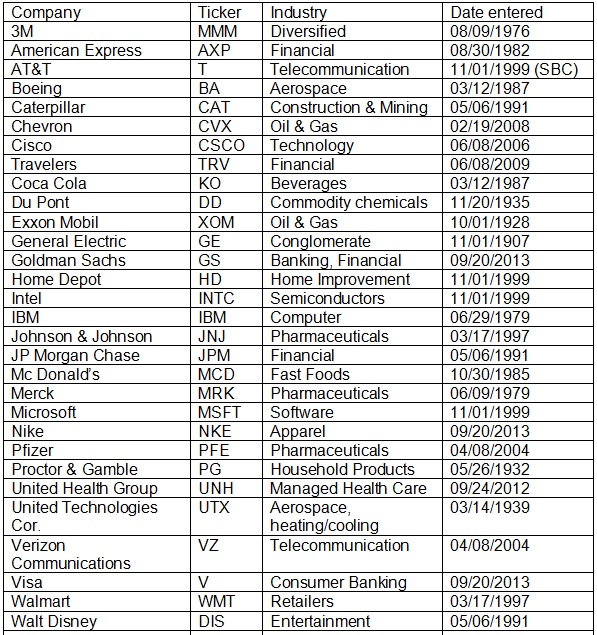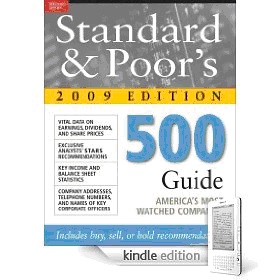




Tìm Kiếm Bài Đã Đăng


Diễn Đàn Cựu Sinh Viên Quân Y
© 2014
© 2014
Chapter Four
Stock Market Indexes
New investors may be confused about marketplaces such as NYSE, AMEX or even NASDAQ (as a quotation system or market place) where securities are traded and indices such as Dow Jones, S&P 5000, or again NASDAQ (as an index). This chapter will deal with the three most referred indices which are the Dow Jones Index, also called Dow Jones Industrial Average, the Standards & Poors 500 or S&P500 and the NASDAQ Composite Index.
The Dow Jones Index
In 1882, to satisfy the growing need of financial information, Charles Henry Dow, Edward Davis Jones and Charles Milford Bergstresser founded Dow, Jones & Company in a small basement located at 15 Wall Street in New York. The company started as a financial media producing hand-written bulletins called “flimsies” which were delivered to the Wall Street’s subscribers in the area. The official Dow Jones Indexes and Averages were created in 1884 by Charles Dow comprising of the sum of prices of 11 stocks. Among those stocks were nine railroads and two industrial companies. Little they knew that more than a hundred years later, the term “Dow Jones” has becoming the most watched index and the compass of all stock markets worldwide.
On July 8, 1889 Dow Jones & Company’s “Customers’ Afternoon Letter” changed its name to the Wall Street Journal until today. In 1897, the number of the Dow Jones stocks grew to 20 railroads companies and the same year, Charles Jones created the Dow Jones Industrial Index composing of 12 companies outside of the railroad industry. Nowadays, the Dow Jones Indexes encompasses a host of different indexes but the three most important indexes are the Dow Jones Industrial Average, the Dow Jones Transportation Average and the Dow Jones Utility Average. Among those three, the most referred is by far the Dow Jones Industrial Average or simply the Dow Jones.
The list of Dow Jones is actually 30 companies (on 09/20/2013) - Fig.1:
Components of Dow Jones are occasionally changed when the market conditions vary. The scale factor used to calculate Dow Jones index is adjusted in order for the value of the average is not affected by the modification. For example, on November 1, 1999 four companies Chevron, Good Year, Sears, and Union carbide were removed and replaced by Intel, Microsoft, Home Depot and SBC. Intel and Microsoft are the first two companies traded on NASDAQ exchange to be included into the Dow 30. This information illustrates the fact that Dow Jones is an index and its components can be traded on different exchanges.
Case-in-point: Intel is traded mostly on NASDAQ (as a market place) but is a component of Dow Jones, S&P 500, NASDAQ Composite and NASDAQ 100 indices.
The S&P 500 Index
For years, the Dow Jones Index has proven to be an accurate predictor of primary market trends but it has faced mounting criticism that it does not embody an exact outlook of the economy in general. Its limited number of companies and most of all, its price-weighted methodology has made analysts uneasy. A wild price’s move of a single Dow’s component may affect the whole index.
Because of the above reasons, Standard & Poor’s, a division of McGraw-Hill Company has come up with the S&P 500, a value-weighted index published since 1957 of 500 large companies traded actively in the United States, either on NYSE or NASDAQ.
History of S&P 500 goes back in 1923 when Standard & Poor’s develops its first stock market indicators. In 1926 the “S&P 90” was created, based on 90 stocks comprising of 50 Industrial, 20 Railroad, and 20 Utility companies. By 1957, the number of components grew to the actual 500 stocks, comprising of 400 Industrials, 40 Utilities, 40 Financials and 20 Transportations. Unlike Dow Jones Index which is price-weighed, meaning the price of a specific stock has direct influence to the index, S&P 500 is value-weighted. The market capitalization of a stock, not solely the stock price of a company, impacts proportionally the index performance.
In 1968, S&P 500 received somewhat an official recognition when the U.S Department of Commerce has chosen the S&P 500 Index as one of the components of its Index of Leading Economic Indicators. Likewise, nowadays, investment professionals use S&P 500, which they call the “market” as a benchmark for mutual funds’ performance. The volatility, or portfolio beta of S&P 500 has been attributed arbitrary a value of 1.00 against which other indexes or stocks are calculated.
S&P 500 Index is managed by a committee who establishes policy guidelines for all S&P Indexes. Typically, the Committee meets about every month, and as often as necessary to discuss about policies, companies reviews and most important, potential replacements of the Index components. Since the Index has been widely used as a basis for other equity markets, replacements may have a significant impact on the market in general, a consequence that the Committee wants to avoid as much as possible. Any company cannot apply for inclusion into the S&P 500 nor does the Committee approach candidates for consideration. All data used in the selection process is public information and the Committee guarded closely its changes and released publicly only when the markets are closed. Nonetheless, such procedures still affect the markets, therefore whenever possible, the Committee announces company replacements up to a week in advance.
The current complete list of S&P 500 can be found at:
<https://www2.standardandpoors.com/portal/site/sp/en/us/page.topic/indices_500/2,3,2,2,0,0,0,0,0,2,3,0,0,0,0,0.html>
The NASDAQ Composite Index
Along with Dow Jones and S&P 500, the NASDAQ Composite is the third most watched Index which captures the performance of technology and growth companies of the stock market. The NASDAQ Composite Index comprises of both U.S. and non-U.S. companies and is not exclusively a U.S. Index.
The NASDAQ Composite Index originates back in 1971 when the NASDAQ Exchange was created. Although most of the securities listed in the Index are common stocks, it includes also a number of American Depository Receipts, Real Estate Investment Trusts (EITS), and Tracking stocks. As such, its components add up to more than 3,000 securities. The methodology used to calculate is market-value weighted, like the S&P 500, therefore, stocks with large market capitalization have a direct impact on the Index rather than the share prices.
To quality for inclusion into the NASDAQ Composite, a stock must be listed on the NASDAQ Stock Market Exchange, unless the company was listed dually on another U.S. market prior to 2004 and has continuously maintained such listing. At any time that a company failed to meet the criteria for inclusion, its stock was removed and may or may not be replaced by another company.
The NASDAQ Composite was launched in January 5, 1971 with a base value of 100 and closed above the 1,000 mark for the first time on July 17,1995 after reaching the all-time low of 54 in October 1974, during 1973-1074 Stock Market Crash following the Yom Kippur War in Middle East and the 1973 Oil Crisis. On March 10, 2000 NASDAQ Composite peaked an all-time high of 5,048 and declined following the burst of the Dot.Com Bubble. Within a year, the NASDAQ Composite dropped to 1,114 and recovered gradually for more than half of its peak, reaching 2,861 in October 2007.
Nonetheless, the financial crisis which started in Fall 2008 pushed the Index back to its low of 1,265 in March 2009. As of August 2009, the NASDAQ Composite made a healthy recovery and passed the 2,000 mark amid hope that the financial meltdown was coming to an end.
Recently at the start of 2014, NASDAQ has passed again the 4,000 mark and shy 18% of its all-time high while Dow Jones and S&P 500 have both made all-time high.
Other indexes
Besides the three most followed market indices described above, a host of other indexes were created to track performances of varied industries and sectors of the economy. Each of the three major indexes has its own sub-indices, for example, in addition to the Dow Jones Index (or more specifically, the Dow Jones Industrial) investors may find interesting to follow the Dow Jones Composite, Dow Jones transportation, Dow Jones Utility of the Global Dow (Dow Jones Indexes, 2009).
Likewise, Standard & Poor’s has also a series of other indexes to track performances of markets all around the world and encompassing most segments of the economy. The complete list may be found at the official website of Standard & Poor’s.
Concurrently, NASDAQ has its own family of other indexes other than the NASDAQ Composite. The NASDAQ-100 Index which represents the 100 largest non-financial companies based on market capitalization is one of the most followed indexes of the stock market in general. The NASDAQ 100 e-minis are ranked right behind the S&P 500 e-minis as the most heavily traded futures contracts.
The Russell 2000 Index is perhaps the fourth most popular index and represents the volatile index for small-cap companies.
Stock Market Indexes
New investors may be confused about marketplaces such as NYSE, AMEX or even NASDAQ (as a quotation system or market place) where securities are traded and indices such as Dow Jones, S&P 5000, or again NASDAQ (as an index). This chapter will deal with the three most referred indices which are the Dow Jones Index, also called Dow Jones Industrial Average, the Standards & Poors 500 or S&P500 and the NASDAQ Composite Index.
The Dow Jones Index
In 1882, to satisfy the growing need of financial information, Charles Henry Dow, Edward Davis Jones and Charles Milford Bergstresser founded Dow, Jones & Company in a small basement located at 15 Wall Street in New York. The company started as a financial media producing hand-written bulletins called “flimsies” which were delivered to the Wall Street’s subscribers in the area. The official Dow Jones Indexes and Averages were created in 1884 by Charles Dow comprising of the sum of prices of 11 stocks. Among those stocks were nine railroads and two industrial companies. Little they knew that more than a hundred years later, the term “Dow Jones” has becoming the most watched index and the compass of all stock markets worldwide.
On July 8, 1889 Dow Jones & Company’s “Customers’ Afternoon Letter” changed its name to the Wall Street Journal until today. In 1897, the number of the Dow Jones stocks grew to 20 railroads companies and the same year, Charles Jones created the Dow Jones Industrial Index composing of 12 companies outside of the railroad industry. Nowadays, the Dow Jones Indexes encompasses a host of different indexes but the three most important indexes are the Dow Jones Industrial Average, the Dow Jones Transportation Average and the Dow Jones Utility Average. Among those three, the most referred is by far the Dow Jones Industrial Average or simply the Dow Jones.
The list of Dow Jones is actually 30 companies (on 09/20/2013) - Fig.1:
Components of Dow Jones are occasionally changed when the market conditions vary. The scale factor used to calculate Dow Jones index is adjusted in order for the value of the average is not affected by the modification. For example, on November 1, 1999 four companies Chevron, Good Year, Sears, and Union carbide were removed and replaced by Intel, Microsoft, Home Depot and SBC. Intel and Microsoft are the first two companies traded on NASDAQ exchange to be included into the Dow 30. This information illustrates the fact that Dow Jones is an index and its components can be traded on different exchanges.
Case-in-point: Intel is traded mostly on NASDAQ (as a market place) but is a component of Dow Jones, S&P 500, NASDAQ Composite and NASDAQ 100 indices.
The S&P 500 Index
For years, the Dow Jones Index has proven to be an accurate predictor of primary market trends but it has faced mounting criticism that it does not embody an exact outlook of the economy in general. Its limited number of companies and most of all, its price-weighted methodology has made analysts uneasy. A wild price’s move of a single Dow’s component may affect the whole index.
Because of the above reasons, Standard & Poor’s, a division of McGraw-Hill Company has come up with the S&P 500, a value-weighted index published since 1957 of 500 large companies traded actively in the United States, either on NYSE or NASDAQ.
History of S&P 500 goes back in 1923 when Standard & Poor’s develops its first stock market indicators. In 1926 the “S&P 90” was created, based on 90 stocks comprising of 50 Industrial, 20 Railroad, and 20 Utility companies. By 1957, the number of components grew to the actual 500 stocks, comprising of 400 Industrials, 40 Utilities, 40 Financials and 20 Transportations. Unlike Dow Jones Index which is price-weighed, meaning the price of a specific stock has direct influence to the index, S&P 500 is value-weighted. The market capitalization of a stock, not solely the stock price of a company, impacts proportionally the index performance.
In 1968, S&P 500 received somewhat an official recognition when the U.S Department of Commerce has chosen the S&P 500 Index as one of the components of its Index of Leading Economic Indicators. Likewise, nowadays, investment professionals use S&P 500, which they call the “market” as a benchmark for mutual funds’ performance. The volatility, or portfolio beta of S&P 500 has been attributed arbitrary a value of 1.00 against which other indexes or stocks are calculated.
S&P 500 Index is managed by a committee who establishes policy guidelines for all S&P Indexes. Typically, the Committee meets about every month, and as often as necessary to discuss about policies, companies reviews and most important, potential replacements of the Index components. Since the Index has been widely used as a basis for other equity markets, replacements may have a significant impact on the market in general, a consequence that the Committee wants to avoid as much as possible. Any company cannot apply for inclusion into the S&P 500 nor does the Committee approach candidates for consideration. All data used in the selection process is public information and the Committee guarded closely its changes and released publicly only when the markets are closed. Nonetheless, such procedures still affect the markets, therefore whenever possible, the Committee announces company replacements up to a week in advance.
The current complete list of S&P 500 can be found at:
<https://www2.standardandpoors.com/portal/site/sp/en/us/page.topic/indices_500/2,3,2,2,0,0,0,0,0,2,3,0,0,0,0,0.html>
The NASDAQ Composite Index
Along with Dow Jones and S&P 500, the NASDAQ Composite is the third most watched Index which captures the performance of technology and growth companies of the stock market. The NASDAQ Composite Index comprises of both U.S. and non-U.S. companies and is not exclusively a U.S. Index.
The NASDAQ Composite Index originates back in 1971 when the NASDAQ Exchange was created. Although most of the securities listed in the Index are common stocks, it includes also a number of American Depository Receipts, Real Estate Investment Trusts (EITS), and Tracking stocks. As such, its components add up to more than 3,000 securities. The methodology used to calculate is market-value weighted, like the S&P 500, therefore, stocks with large market capitalization have a direct impact on the Index rather than the share prices.
To quality for inclusion into the NASDAQ Composite, a stock must be listed on the NASDAQ Stock Market Exchange, unless the company was listed dually on another U.S. market prior to 2004 and has continuously maintained such listing. At any time that a company failed to meet the criteria for inclusion, its stock was removed and may or may not be replaced by another company.
The NASDAQ Composite was launched in January 5, 1971 with a base value of 100 and closed above the 1,000 mark for the first time on July 17,1995 after reaching the all-time low of 54 in October 1974, during 1973-1074 Stock Market Crash following the Yom Kippur War in Middle East and the 1973 Oil Crisis. On March 10, 2000 NASDAQ Composite peaked an all-time high of 5,048 and declined following the burst of the Dot.Com Bubble. Within a year, the NASDAQ Composite dropped to 1,114 and recovered gradually for more than half of its peak, reaching 2,861 in October 2007.
Nonetheless, the financial crisis which started in Fall 2008 pushed the Index back to its low of 1,265 in March 2009. As of August 2009, the NASDAQ Composite made a healthy recovery and passed the 2,000 mark amid hope that the financial meltdown was coming to an end.
Recently at the start of 2014, NASDAQ has passed again the 4,000 mark and shy 18% of its all-time high while Dow Jones and S&P 500 have both made all-time high.
Other indexes
Besides the three most followed market indices described above, a host of other indexes were created to track performances of varied industries and sectors of the economy. Each of the three major indexes has its own sub-indices, for example, in addition to the Dow Jones Index (or more specifically, the Dow Jones Industrial) investors may find interesting to follow the Dow Jones Composite, Dow Jones transportation, Dow Jones Utility of the Global Dow (Dow Jones Indexes, 2009).
Likewise, Standard & Poor’s has also a series of other indexes to track performances of markets all around the world and encompassing most segments of the economy. The complete list may be found at the official website of Standard & Poor’s.
Concurrently, NASDAQ has its own family of other indexes other than the NASDAQ Composite. The NASDAQ-100 Index which represents the 100 largest non-financial companies based on market capitalization is one of the most followed indexes of the stock market in general. The NASDAQ 100 e-minis are ranked right behind the S&P 500 e-minis as the most heavily traded futures contracts.
The Russell 2000 Index is perhaps the fourth most popular index and represents the volatile index for small-cap companies.
Loading












